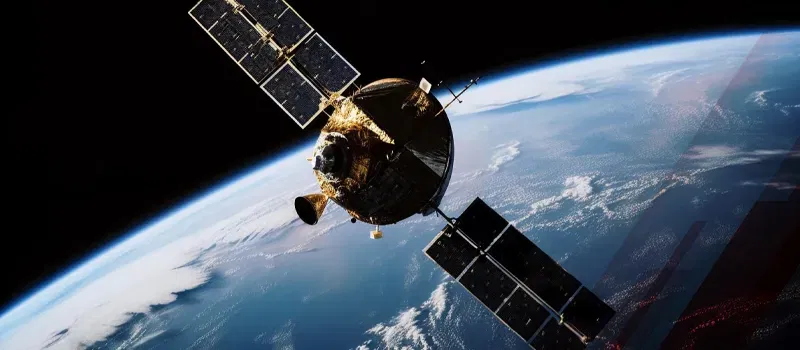Author : Priyanka | September 28, 2023
On July 14, 2023, the success of ISRO resounded as Chandrayaan 3 set out on its mission, inspiring other countries to strive for their success in space exploration. But do you know, in the vast expanse of space where satellites roam and explore, what is the hidden force that propels them forward, defying gravity's grasp and charting new frontiers? It's the mesmerizing world of satellite propulsion systems.
Having said that, let's take a closer look into the realm of satellite propulsion systems, where dreams of reaching the stars become a captivating reality.
The Incredible Potential of Satellite Propulsion Systems
Satellite propulsion systems encompasses various techniques and technologies employed to furnish propulsion and guidance for satellites and spacecraft in the void of space. These systems play a crucial role in the maneuvering, orbit maintenance, and positional adjustments of satellites.
One of the significant potentials of satellite propulsion systems is to extend the lifespan of satellites, enabling them to maintain their orbits and make necessary adjustments over time. This is crucial for data gathering, observations, and missions like weather forecasting and Earth monitoring. These systems also enable interplanetary missions, allowing spacecraft to explore other planets and celestial bodies. Moreover, they impact commercial applications by facilitating global internet coverage, remote sensing, and communication services. They further pave the way for future space missions, including human space exploration and interstellar travel. As scientists and engineers continue to innovate, more groundbreaking discoveries are expected in space exploration.
According to the latest report by Kings Research, the global satellite propulsion systems market is likely to be worth USD 3.78 billion by 2030, growing at 6.51% CAGR between 2023 and 2030. This statistic indicates the potential opportunities for growth in the market in the future.
Major Types of Satellite Propulsion Systems
Satellite propulsion systems can be classified into various types, each with unique features and uses. Here are common types of these systems.
- Chemical Propulsion Systems
These systems utilize chemical reactions to generate thrust. They often use liquid or solid propellants, such as hydrazine or nitrogen tetroxide. Chemical propulsion systems are known for providing high thrust and are commonly used for large satellites and spacecraft.
- Electric Propulsion Systems
Electric propulsion systems employ electrical power to ionize and accelerate a propellant. They are known for their high efficiency and long-duration capabilities. Examples of electric propulsion systems include ion thrusters, Hall effect thrusters, and magnetoplasmadynamic thrusters.
Electric propulsion systems (EPS) are increasingly used in space missions, particularly in Europe for commercial satellites. EPS is considered revolutionary for new satellite generations.
- Hybrid Propulsion Systems
Hybrid systems combine elements of both chemical and electric propulsion, offering a balance between high thrust and high efficiency. They may use a combination of propellant types or stages to achieve optimal performance.
- Cold Gas Propulsion Systems
Cold gas propulsion systems use compressed gas, such as nitrogen or xenon, to generate thrust. These systems are simple, reliable, and generally employed for attitude control and small maneuvers.
- Solar Sail
Solar sail propulsion systems use the pressure of sunlight to propel a spacecraft. By reflecting or absorbing photons, the solar sail generates thrust and can allow for long-duration missions.
For further information, NASA and Aerojet Rocketdyne are testing advanced solar electric propulsion thrusters for Gateway, a lunar space station. The Advanced Electric Propulsion System (AEPS) will provide 12 kilowatts of propulsive power, two times more powerful than current systems. The thrusters are designed for use on the PPE (Power and Propulsion Element) to maneuver Gateway during its 15-year mission.
- Nuclear Propulsion (Conceptual)
Nuclear propulsion systems, still in conceptual stages, involve the use of nuclear reactions or energy to generate thrust. These systems have the potential for high efficiency and long-duration missions.
NASA is exploring nuclear propulsion systems for Mars missions, including nuclear electric and thermal propulsion, to minimize crew travel time and optimize planetary alignment for low-energy and higher-energy transits.
The choice of propulsion system for a satellite mission depends on mission requirements, resources, and duration. These systems enable satellites to maintain orbits, perform complex maneuvers, and extend operational lifetimes, playing a crucial role in communication, Earth observation, and scientific research.
The Next Frontier in Satellite Propulsion Systems
NASA’s in-space propulsion devices for small spacecraft are observing increasing adoption. Some systems and components with past flight heritage are being reconsidered to meet the requirements of smaller spacecraft, minimizing new product development risk and time to market. Others are being developed specifically for small spacecraft using innovative approaches to propulsion system design, manufacturing, and integration. These new technologies aim to offer propulsives capacity not easily matched with the miniaturization of heritage technologies, often highly integrated & optimized to lower the use of a spacecraft's limited resources, reduce product costs, and simplify integration.
The extensive investments by commercial industry, academia, and government suggest long-term growth in the availability of propulsion devices with increasingly diverse capabilities. NASA has curated a report that serves the purpose of reducing confusion. It achieves this by assembling a comprehensive list of publicly disclosed small spacecraft propulsion systems, identifying publicly accessible technical literature, acknowledging missions of potential importance, and structuring the data to enhance understanding for both novices and experts in the field.
Mastering the Art of Space Navigation
Satellite propulsion systems have emerged as a game-changing technology that is propelling us into a new era of space exploration. With their unparalleled speed, precision, and efficiency, these systems are revolutionizing the way we navigate and communicate in space. From enabling interplanetary missions to extending the lifespan of satellites, advancements in satellite propulsion have opened up endless possibilities for scientific discovery, commercial ventures, and even the potential for interstellar travel. The future is indeed bright for satellite propulsion systems, and we can only imagine the remarkable achievements that lie ahead.
